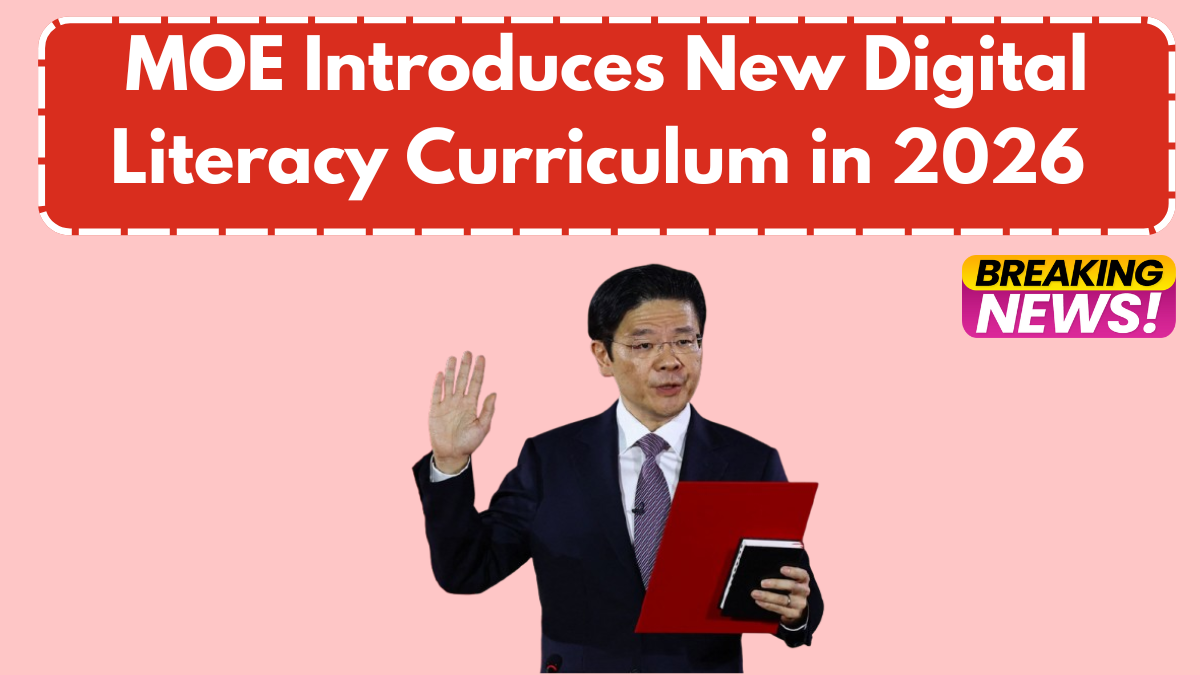In a strategic move to align national education with the evolving demands of the digital world, the Ministry of Education (MOE) in Singapore has announced a comprehensive Digital Literacy Curriculum Singapore 2026. This major initiative aims to build robust tech capabilities in students across primary and secondary levels, preparing them for the increasingly digitalized global landscape.

Why the Digital Literacy Curriculum Matters in 2026
The new framework is part of the MOE 2026 education update, reflecting a broader transformation in Singapore’s school curriculum. The updated syllabus emphasizes not just basic computing, but also ethical technology use, cybersecurity awareness, and the fundamentals of coding and data handling. This shift comes at a time when digital fluency is no longer optional—it’s essential for both academic and workplace success.
As part of the Singapore school curriculum changes, this rollout introduces tech skills for students as early as Primary 1. The idea is to embed digital competence at every stage of learning, cultivating future-ready citizens who are not only consumers of technology but also creators and critical thinkers.
Key Features of the New Curriculum
The Digital Literacy Curriculum Singapore 2026 is designed with a multi-tiered approach. Below is a table summarizing the major components across different education levels:
| Education Level | Key Digital Literacy Focus Areas |
|---|---|
| Primary (P1–P6) | Safe internet use, keyboard skills, digital storytelling |
| Lower Secondary | Basic programming, digital collaboration tools |
| Upper Secondary | Cybersecurity, ethical tech use, data analysis |
| Pre-University (JC/ITE) | Applied AI concepts, cloud computing, advanced coding |
The curriculum also integrates digital literacy across traditional subjects, ensuring students apply these skills in real-world contexts—from mathematics and science to humanities and the arts.
What Parents Should Expect from MOE 2026 Education Update
Parents will notice a more tech-integrated classroom environment starting January 2026. Lessons will involve a mix of hands-on digital projects, peer collaboration on online platforms, and responsible digital behavior training. Schools are being equipped with updated devices, and teachers are undergoing extensive training to deliver these lessons effectively.
The MOE has emphasized parental involvement as critical to the success of the curriculum. Workshops and digital parenting resources will be provided to help parents stay informed and support their children’s development. This includes guidance on managing screen time, understanding online safety tools, and encouraging meaningful tech engagement at home.
Long-Term Impact on Students and the Future Workforce
By embedding these tech skills for students early on, the Digital Literacy Curriculum Singapore 2026 hopes to address the growing digital divide and prepare youth for jobs that may not yet exist. From cybersecurity specialists to AI ethicists, the range of future careers demands a solid digital foundation.
This curriculum also reinforces the importance of digital citizenship. Students will learn how to navigate online spaces responsibly, think critically about digital content, and understand the societal impacts of emerging technologies.
How Schools Are Preparing for the Transition
MOE has partnered with industry experts and tech firms to co-develop modules that reflect current and future industry needs. Pilot programs launched in selected schools during 2024 and 2025 have shown promising results, with increased student engagement and improved digital competencies.
Schools are also being encouraged to adopt flexible learning models, including blended learning and project-based tech assignments, to cater to diverse student needs and learning styles. This adaptability is key to ensuring no student is left behind during the transition.
FAQs
What is the main goal of the Digital Literacy Curriculum Singapore 2026?
The goal is to equip students with essential digital skills, including ethical tech use, cybersecurity knowledge, and foundational coding, to prepare them for the future economy.
When will the new curriculum be implemented?
The Digital Literacy Curriculum will be implemented across all primary and secondary schools starting in January 2026.
How will parents be involved in this change?
Parents will be supported through MOE workshops, digital guides, and regular updates to help them engage with and support their child’s digital learning journey.
What makes this curriculum different from earlier ICT programs?
Unlike previous ICT programs that focused on basic computer usage, this curriculum integrates real-world applications, digital ethics, and advanced tech topics like data analysis and AI concepts.
Will students need personal devices for this curriculum?
Most schools will provide access to digital devices during class, but families may be encouraged to have basic digital tools at home to reinforce learning.
Click here to know more.
Akesh is a talented content writer known for creating captivating and impactful narratives. He understands what resonates with audiences and tailors his content to inform, inspire, and engage. From blog posts and articles to marketing copy, his work consistently combines creativity with clarity. His skillful writing strengthens our brand’s voice and ensures our message leaves a meaningful impression.



